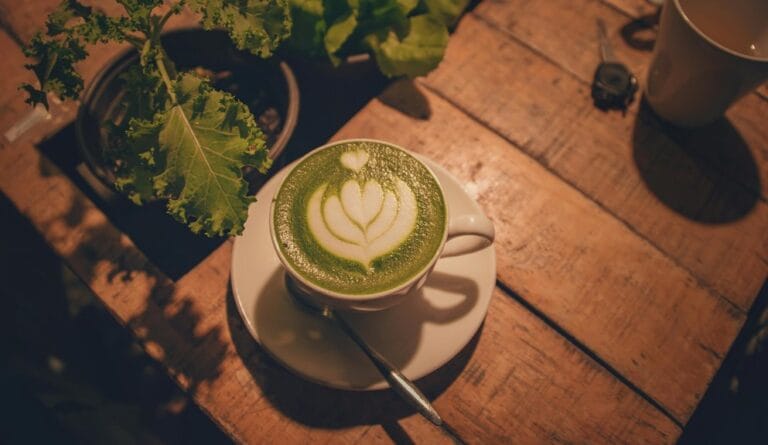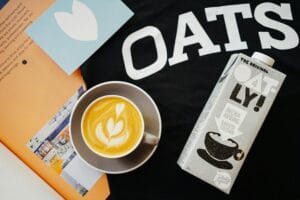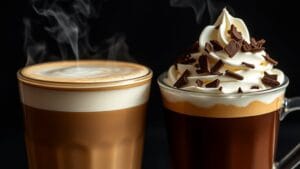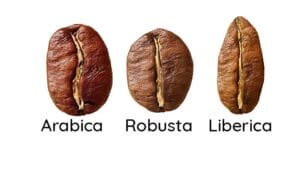A grande Starbucks Matcha Latte has about 80mg of caffeine, just under a coffee’s kick but smoother, pairing buzzy vibes with calming L-theanine for steady focus. Unlike jittery espresso shots, this bright green drink uses sweetened matcha powder scooped by baristas (each adds ~20mg), letting you tweak your zen-to-energy ratio. Want less? Order fewer scoops or try oat milk for slower absorption. Coffee lovers, note: matcha’s stealth-mode caffeine takes 3-4 hours to fade, like a ninja leaving gently. Craving more hacks? The deeper exploration awaits.
The Matcha Caffeine Confusion

Why do some people feel wide awake after sipping a creamy green latte, while others swear by their classic coffee buzz? The answer boils down to caffeine magic!
Caffeine’s magic: matcha delivers calm alertness, while coffee revs up a jittery buzz.
A grande Matcha Latte from Starbucks packs around 80mg of caffeine, way less than your average iced coffee (140-190mg).
But here’s the kicker: matcha’s caffeine teams up with L-theanine, a chill compound that stops jitters but keeps your brain zingy. Free-spirited sippers love the smooth, steady energy, like a zen ninja doing yoga on a caffeine cloud.
Want numbers? How much caffeine is in a grande matcha latte? Eighty milligrams—enough to perk you up without launching you into orbit.
Matcha vs. Coffee: Why Quantification Matters

Comparing matcha and coffee isn’t just flavor—Starbucks uses pre-sweetened matcha blends, which use fewer actual tea leaves, hiding lower caffeine per scoop versus coffee’s straightforward grounds-to-cup ratios.
Coffee’s brewing standards guarantee higher caffeine hits, while matcha lattes rely on precise scoop counts, leaving drinkers guessing if they’re sipping zen vibes or real energy.
Without clear caffeine labels, choosing between them feels like solving a math problem with a calculator made of… well, matcha powder.
The Matcha Quantity Trap
While both matcha lattes and coffee can perk you up, their caffeine punches work totally differently, like comparing a firecracker to a slow-burning sparkler.
Coffee hits fast and hard, cranking energy instantly but leaving behind jitters or crashes. Matcha, though, rolls in smoother, mixing caffeine with L-theanine—a chillax compound—to stretch focus over hours.
Here’s the trap: Starbucks’ matcha blend packs sugar initially, tea afterwards. A grande has 80mg caffeine, but also 28g sugar—like glugging six Oreos.
Skipping bitter, grassy pure matcha for a sweeter sip trades calm energy for sugary spikes, hiding benefits in a dessert disguise.
Chasing caffeine freedom? Watch portion sizes and custom orders—less sugar, more tea powder equals cleaner zest without the crash-and-burn. Additionally, it’s crucial to remember that caffeine content in tea varies depending on preparation method and tea type.
Balance, folks: it’s not witchcraft, just math.
Starbucks Brewing Standards
At Starbucks, precision isn’t just for science class, it’s the secret sauce in every drink.
Brewing standards guarantee consistency, whether you’re sipping coffee or matcha. Coffee uses strict water-to-grounds ratios, while matcha blends sugar and powdered tea leaves in exact proportions.
Why does this matter? Quantifying ingredients assures caffeine predictability: a grande iced matcha latte packs 80mg caffeine, far less than coffee’s 140-190mg. This precision lets rebels with espresso jitters switch to matcha’s calm buzz.
Baristas follow step-by-step recipes, measuring scoops, milk types, ice levels—no guesswork. Even the cup size controls caffeine intake, so reliability meets freedom.
Think of it as a caffeine buffet, not a science test (no lab coat required). Now, choose your potion, knowing Starbucks’ math has your back.
Grande Matcha Latte: The Verified 80mg Caffeine
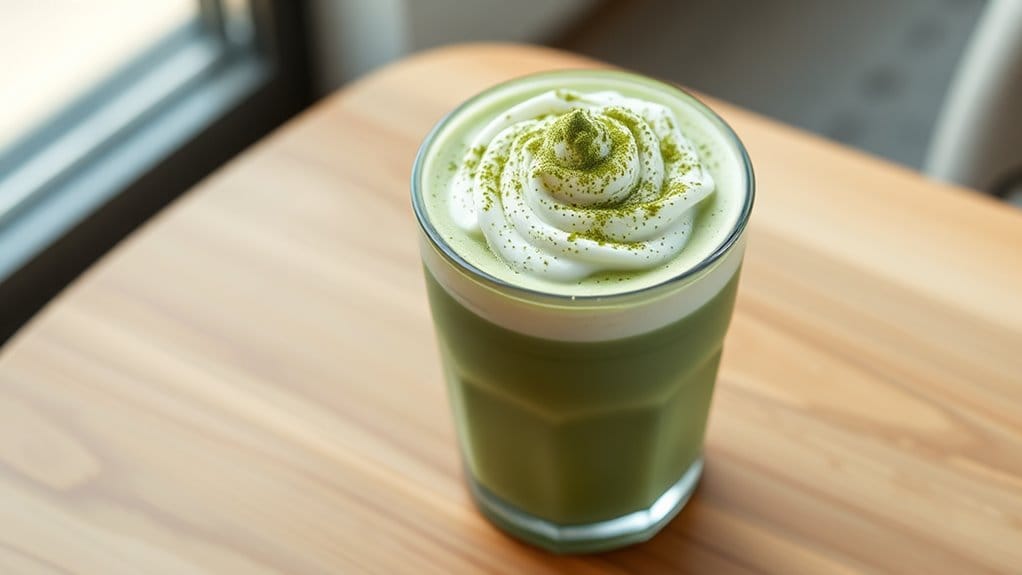
A grande Starbucks Matcha Latte packs 80 milligrams of caffeine, giving coffee drinks a run for their money while dodging the harsh crashes. That caffeine comes straight from its vibrant green matcha powder, a blend of sugar and finely ground Japanese tea leaves.
The kick? Smooth, steady, and sneaky, thanks to matcha’s natural combo of caffeine and L-theanine, which pairs energy with calm focus—no jitters, no post-buzz nosedives. It’s like a chilled-out rocket fuel.
For folks craving control over their buzz, this drink’s customizable: swap milks, adjust sweetness, or ditch the whipped cream.
Whether you’re powering through spreadsheets or chasing summer sun, the grande size strikes a balance—enough pep to stay sharp but not so much you’ll start reciting Shakespeare.
Freedom in a cup? You bet.
Coffee Comparisons
When comparing caffeine sources, matcha offers a unique twist with its calm energy, unlike coffee’s quick jolt. Espresso packs 75mg per shot vs. matcha’s 80mg, while brewed coffee hits harder (140-190mg) and green tea stays mellow (25-40mg). Each drink has its perks: coffee’s bold kick, matcha’s zen-like buzz, and green tea’s gentle lift, all tied to personal taste. Additionally, the appreciation for high-quality beans can influence your preference for coffee over matcha or vice versa. Interestingly, the caffeine concentration varies between drinks, as espresso’s impact is felt quickly while Americanos provide a more diluted experience.
| Caffeine Source | Typical Caffeine per Serving | Key Characteristics |
|---|---|---|
| Espresso | 75mg per shot | Quick hit, rich flavor, handy for focus |
| Brewed Coffee | 140-190mg (Grande) | Strong buzz, bold taste, *crash warning* |
| Green Tea | 25-40mg (8oz) | Light lift, herbal notes, zen vibes |
| Matcha Latte | 80mg (Grande) | Smooth energy, grassy flavor, no jitters! |
Espresso vs. Matcha
The showdown between espresso and matcha is a caffeine battle with different rhythms, flavors, and vibes. Espresso punches hard, packing 75mg of caffeine in a 1.5-ounce shot, while matcha shakes things up with a slower release of 80mg in a grande serving, thanks to L-theanine smoothing out the buzz.
Espresso roars with bold, bitter notes, like a rock song for your taste buds, while matcha hums earthy, grassy tones, like sipping a zen garden.
Need a lightning bolt of energy? Espresso fires fast, perfect for sprinting through deadlines. Prefer a mellow marathon? Matcha’s steady alertness keeps you cruising.
Both drinks flex with customization—espresso in lattes, macchiatos, or solo; matcha shaken with milk, sugar, or straight-up.
Choose your fighter: instant grits or slow-cooked oats, but with caffeine.
Brewed Coffee vs. Matcha
Brewed coffee and matcha throw down in a caffeine showdown, like two siblings arguing over who makes mornings better.
A grande Starbucks brewed coffee packs a punch with roughly 310mg of caffeine, while a matcha latte serves up just 80mg. Coffee races through your veins, fueling quick energy spikes (and maybe jitters), while matcha’s earthly green magic releases energy slowly, thanks to the calming L-theanine tag-teaming with caffeine. Additionally, the specific parameters of espresso brewing emphasize the importance of precise brewing methods in coffee preparation.
Flavor-wise, coffee brings bold, roasted intensity—think campfire vibes—while matcha offers grassy sweetness, like a fresh meadow in a cup.
Both let you customize milk or sweetness at Starbucks, but matcha’s zen-like focus might beat coffee’s chaotic buzz. Additionally, coffee culture has transformed into global social hubs beyond just caffeine access, offering spaces for community and connection.
Pick coffee for raw power, matcha for chill vibes, or flip a coin and let freedom—not caffeine—rule your day.
Green Tea vs. Matcha
Green tea and matcha, like leafy siblings from the same plant, battle it out in the caffeine ring, one a mellow sip, the other a vibrant kick. Green tea steeps whole leaves, releasing gentle caffeine (25-45mg per cup), while matcha grinds young leaves into powder, delivering a bolder 70mg per serving—since you’re sipping the whole leaf.
Both boast antioxidants, but matcha’s higher chlorophyll and L-theanine levels mean stronger detox perks and calm energy (no coffee jitters!). Green tea whispers zen gardens; matcha shouts ninja energy.
At Starbucks, the matcha latte blends sweetened powder with milk, offering customizable freedom—dairy swaps, sugar tweaks, fluffy whipped cream! Additionally, caffeine content by size shows how various drinks at Starbucks, including chai and espresso options, fit into your daily intake.
Together, they prove that caffeine isn’t just black coffee: it’s a leafy duel of tradition vs. turbocharged sipping.
Common Myths Debunked
Let’s smash some myths faster than a blender crushes ice!
Many think iced matcha lattes have less caffeine, organic options are lower, or that the drink is caffeine-free. Spoiler: nope, nope, and nope!
– Myth: Iced lattes have less caffeine.
Truth: Temperature doesn’t change caffeine—Starbucks uses the same matcha powder, hot or cold.
– Myth: “Organic” = lower caffeine.
Truth: Caffeine comes from tea leaves, not farming labels—organic or not, it’s the same buzz.
– Myth: Matcha lattes are caffeine-free.
Truth: They pack ~80mg caffeine (grande size), like a shot of espresso, but without the jitters!
– Myth: More ice = weaker drink.
Truth: Ice just chills it; caffeine stays steady unless the recipe changes (*spoiler: it doesn’t*).
– Myth: Switching milks changes caffeine.
Truth: Milk adds creaminess, not caffeine—dairy or oat, your energy enhancement stays locked in.
Iced Has Less Caffeine
A common coffee shop myth swirls around like cream in a latte: the belief that iced drinks pack less caffeine just because they’re served cold.
Spoiler alert: temperature doesn’t zap caffeine! Starbucks’ Iced Matcha Latte, for example, contains roughly 80mg of caffeine in a grande, mirroring its hot counterpart. The mix of matcha powder, milk, and ice remains consistent—no sneaky caffeine shortcuts.
Some assume dilution from melting ice lowers caffeine, but recipes account for that, balancing flavor and strength. Want freedom from misconceptions? Order your iced drink boldly, knowing it delivers the same vibrant green energy.
Cold? Hot? It’s all about preference, not potency. Myths melt faster than whipped cream on a sunny day—enjoy your buzz, chill or steamed!
Organic = Lower Caffeine
Some caffeine lovers assume organic coffee has less kick, thinking “natural” means milder, but caffeine doesn’t care about farming labels! That jittery magic molecule’s strength depends on the plant itself, not fertilizer types.
Organic matcha or coffee might skip synthetic chemicals, but their caffeine stays just as bold. Starbucks’ matcha blend (organic or not) packs the same ~80mg in a grande latte, straight from tea leaves.
It’s like assuming a wild lion raised on organic gazelles would be tamer—nope, it’s still a lion. Farming practices shape environmental impact, not caffeine’s punch.
Want less buzz? Skip the myth, adjust your order: fewer scoops, more milk. Organic is great for many reasons, but being a sleepy-time brew ain’t one. Caffeine’s the ultimate rebel—untamed by labels!
Matcha Latte Is Caffeine-Free
Despite its smooth, zen-like vibes, a matcha latte isn’t a sneaky caffeine-free drink—its green tea powder comes from leaves loaded with natural caffeine, just like regular tea or coffee. Busted!
The myth likely stems from matcha’s calm reputation, but that chill vibe isn’t from being caffeine-less. A grande matcha latte packs around 80mg of caffeine, less than coffee but enough to give a gentle energy lift.
Caffeine occurs naturally in tea plants, so any matcha drink made from real leaves has some—even the sugary, creamy versions at Starbucks.
Let’s clear the haze: meditation-friendly or not, matcha lattes are simply *different* energy sources, not magic moonbeams. Want freedom from jitters? Matcha pairs caffeine with L-theanine for a smoother ride.
Still green, still mean (in a caffeine way).
Personalizing Your Matcha Experience
| Size & Option | Caffeine Amount |
|---|---|
| Grande (Full Scoop) | 80mg |
| Tall (Half Scoop) | 30mg |
| Decaf | 0mg |
| Notes | Adjustable with extra shots! |
Whether you’re chasing midday focus, a gentle morning perk, or zero-caffeine magic, there’s a matcha mix waiting to match your vibe.
Grande Full Scoop (80mg)
Imagine a matcha latte that’s as unique as your morning vibe, blending smooth green tea powder with a caffeine kick perfect for starting slow or diving into the day.
The Grande Full Scoop (80mg) packs all the matcha power of Starbucks’ sweetened blend, delivering steady energy without the jitters—like coffee’s chill cousin.
With whole milk as the default, it’s creamy and indulgent, but oat, almond, or coconut milk swap in easily for plant-based vibes.
At 80mg caffeine, it’s lighter than espresso but enough to hit that sweet spot between “cozy mug” and “let’s go.”
Want sweeter? The pre-mixed blend has you covered.
Need flexibility? Adjust milk choices, skip toppings, or play with ratios. This scoop’s your canvas—no caffeine jetpack required.
Tall Half Scoop (30mg)
The Tall Half Scoop (30mg) turns down the caffeine volume while keeping that earthy matcha flavor front and center.
Think of it as a “light mode” for your latte—smooth, mellow, and easier on the energy buzz. With half the caffeine of a grande, it’s perfect for those who crave matcha’s grassy sweetness but want to chill, not sprint.
Customize it your way: swap whole milk for almond, oat, or soy to dial in your vibe, or adjust sweetness if the pre-blended sugar feels too bold.
This size whispers, “relaxation,” not “rollercoaster,” making it ideal for lazy afternoons or pairing with a chocolate croissant (no judgment here).
It’s matcha, just quieter—because sometimes you want the taste without the turbo enhancement.
Decaf Options (0mg)
Decaf matcha lattes ditch the caffeine kick while keeping that smooth, grassy flavor fans love, letting anyone enjoy the drink without the buzz.
Starbucks doesn’t offer *official* decaf matcha, but creative swaps work—requesting less matcha powder cuts caffeine, or try caffeine-free herbal alternatives like barley tea powder.
Customize with oat, almond, or coconut milk for extra personal flair, and skip added syrups if sweetness isn’t your jam.
Prefer DIY? Blend ceremonial-grade matcha (lower caffeine) with hot water and steamed milk at home, controlling every sip.
It’s perfect for late-afternoon cravings, yoga-break sips, or pretending you’re a Zen master (minus the jitters).
Freedom’s the name of the game—craft your creamy, earthy drink however it fits your vibe, energy, or Netflix-binge needs.
Ordering Tips for Caffeine Control
While that vibrant green latte might tempt you with its creamy goodness, keeping caffeine in check at Starbucks is easier than solving a Rubik’s Cube one-handed! For caffeine-conscious sippers, a few tweaks reveal freedom without sacrificing flavor.
- Go “short” or “tall”: The grande (16 oz.) packs 80mg caffeine, but a “short” (8 oz.) cuts it in half, like trimming a wild hedge to bonsai size.
- Milk-swap magic: Substitute whole milk with almond or coconut milk. Fewer calories? Sure! Neutral flavor? You bet—no caffeine surprise guests.
- Scoop sabotage: Ask for fewer matcha scoops (each adds ~20mg caffeine). “Just one scoop, please” turns it into a decaf-level whisper.
- Dodge espresso shots: Baristas don’t add espresso to matcha lattes by default, but *always check*—accidental caffeine grenades hurt!
- Sugar-free sweeteners: Skip Starbucks’ pre-sweetened matcha blend (it has sugar but *not* extra caffeine). DIY sweetness with stevia for full control.
Pro tip: Want “babyccino mode”? Order an iced steamed milk with *zero* matcha… but why live life on mute?
Frequently Asked Questions
Can I Order Starbucks Matcha Latte Without Added Sugar?
Like a river tracing its true course, customization reigns. The matcha blend itself is pre-sweetened, but adjustments can dial back excess sugar: request no added syrups, substitute milk, or investigate lower-sugar “Better Bite” options for a lighter flow.
Does Starbucks Use Ceremonial or Culinary Grade Matcha?
Starbucks uses a pre-sweetened culinary-grade matcha blend mixed with sugar, not ceremonial grade. Ceremonial-grade matcha is higher quality, reserved for traditional preparation, while culinary-grade is cost-effective for flavored beverages like lattes.
Is Starbucks Matcha Latte Suitable for a Keto Diet?
Starbucks’ Matcha Latte contains 28g sugar and 29g carbohydrates in a grande serving, primarily from its pre-sweetened mix. These values conflict with standard keto macros, making it unsuitable without significant modifications to milk or sweeteners.
How Does the Caffeine Content Change With Non-Dairy Milk?
Swapping dairy for frothy almond or creamy oat releases a whirlwind of flavor liberation, yet caffeine stands resolute—unbound by milk choice, its 80mg punch persists, unyielding to plant-based whims in Starbucks’ matcha blend.
Are There Seasonal Variations of the Matcha Latte Available?
Starbucks occasionally introduces seasonal Matcha Latte variations, such as winter peppermint infusions or fruit-flavored summer twists. However, core offerings remain constant. Limited-time releases may incorporate regional or collaborative flavors, allowing customizable adaptations year-round.

